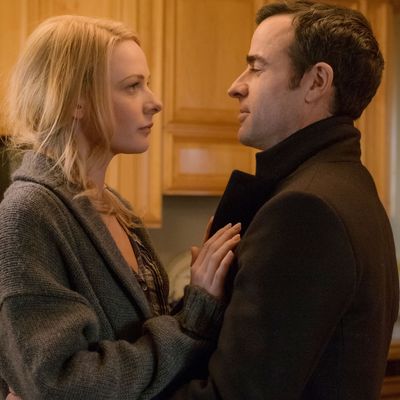
According to UniversalÔÇÖs promotional materials,┬áThe Girl on the Train┬áis based on ÔÇ£the thriller that shocked the world.ÔÇØ High expectations!┬áIf the book version of The Girl on the Train shocked the world, then you might think the film version should be equally, if not more, shocking. ItÔÇÖs just math. So is it?
Spoilers for The Girl on the Train below.
Unfortunately, no ÔÇö the main twist in the movie is about as shocking as an actual ride on Metro North.
The film centers on the disappearance of Megan, a woman that Emily BluntÔÇÖs Rachel sees every morning on her ride into New York City. Megan, played with Jennifer Lawrenceian Jennifer Lawrenceness by Haley Bennett, represents the idealized life that Rachel could have had, had she not been an alcoholic. To make matters worse, Megan lives only a few doors down from RachelÔÇÖs ex, Justin TherouxÔÇÖs Tom, who is now married to Anna (Rebecca Ferguson), the woman he cheated on Rachel with. On the morning of MeganÔÇÖs disappearance,┬áRachel notices Megan canoodling not with her husband Scott (Luke Evans), but with her therapist Dr. Kamal Abdic┬á(Edgar Ramirez). ItÔÇÖs┬áenough to send Rachel on a martini-fueled bender; when she wakes up from her blackout, Megan is gone. Mystery established!
The Girl on the Train quickly sets up three main suspects in MeganÔÇÖs disappearance: Scott, who has a motive and a temper; Dr. Abdic, who is a psychiatrist, and psychiatrists are always suspects; and Rachel, whose memory of the night is spotty. Did she murder Megan in an alcoholic rage?
ItÔÇÖs pretty clear that she didnÔÇÖt, not only because Rachel is played by Emily Blunt, but also because it is so, so obvious that Tom killed Megan. We get our first clue early on, when Megan quits her job babysitting for Tom and AnnaÔÇÖs kid for no reason ÔÇö unless Girl on the Train was really interested in the vagaries of child care (itÔÇÖs not), there must be some hidden┬ápsychosexual drama going on. Furthermore, Roger EbertÔÇÖs┬áLaw of Economy of Characters┬ápoints another finger towards him: If Tom wasnÔÇÖt the bad guy, then he wouldnÔÇÖt be a character that a talented actor like Justin Theroux would want to play.
But no matter how telegraphed the filmÔÇÖs ending is, thereÔÇÖs still a twist. But itÔÇÖs a different kind of twist ÔÇö a literal twist. As grown adults who recognize narrative structure, when we come to Rachel and TomÔÇÖs big confrontation at the end, weÔÇÖre prepared for Rachel to do something to win the day. What we are not prepared for is for Rachel to plunge a corkscrew into TomÔÇÖs neck like sheÔÇÖs opening an affordable, yet nuanced, bottle of Cabernet.
And despite having seen Rachel use the corkscrew as a weapon, we are still not unprepared for what happens next, when Anna leans in and twists the corkscrew, opening the neck of her husband as if sheÔÇÖs opening an affordable, yet nuanced, bottle of Cabernet.
ÔÇ£ThatÔÇÖs the real twist,ÔÇØ my colleague Kyle Buchanan said after we left the movie, and I agree. But I agree for reasons beyond just the pun (which, to be fair, is a great pun). In that moment, we see the culmination of a strange thread running through The Girl on the Train ÔÇö┬áits surprising gruesomeness. By the time weÔÇÖve gotten to AnnaÔÇÖs fateful turn of the wrist, weÔÇÖve already seen a woman get her head smashed in with a rock, witnessed the implied drowning death of an infant, and sat through numerous visions of Rachel pulling MeganÔÇÖs hair and slamming her into the ground.
For a middlebrow thriller, The Girl on the Train leans heavily into the specter of violence that seems to exist within seemingly respectable LandsÔÇÖ End homes. This is hardly new territory ÔÇö in fact, itÔÇÖs among the oldest territories in American cinema ÔÇö but it belies the suggestion that the filmmakers are far more interested in the capacity for murder possessed by every human being, than in which particular human being dunnit this time. If The Girl on the Train is about anything other than covert day-drinking and Westchester living rooms, itÔÇÖs about that. This is a violent movie that doesnÔÇÖt seem to realize how violent it is.

